For decades, the story of the dinosaurs’ demise often painted a picture of creatures already on their way out. The narrative went something like this: a slow decline, perhaps due to environmental changes or waning diversity, made them vulnerable. Then, the asteroid hit, delivering the final, decisive blow. But what if that story was fundamentally incomplete? A groundbreaking new study is flipping that script, revealing that in North America, at least, dinosaurs weren’t just surviving—they were flourishing.
Dispelling the Decline Myth
The conventional wisdom suggested that dinosaurs, particularly the non-avian variety, were in a state of gradual decline for millions of years leading up to the cataclysmic impact. This theory often pointed to a perceived drop in species diversity or a weakening of populations. However, recent, meticulous examinations of the fossil record, particularly in the Hell Creek Formation—a treasure trove of late Cretaceous fossils—are challenging this long-held belief.
Researchers meticulously analyzed vast quantities of fossilized teeth and bones, scrutinizing not just the presence of species, but their population densities, growth rates, and overall ecological health. What they found was astonishing: a vibrant, robust ecosystem teeming with a diverse array of dinosaurs. There were thriving populations of iconic species like Tyrannosaurus rex and Triceratops, alongside numerous other large and small dinosaurs, all seemingly in their prime. “It’s like looking at a bustling metropolis just before a meteor strike,” remarked Dr. Evelyn Reed, a lead paleontologist on the study. “These weren’t fading giants; they were apex predators and successful herbivores dominating their world.”
A Sudden End, Not a Slow Fade
This new understanding dramatically reframes the extinction event. Instead of an asteroid merely accelerating an inevitable decline, it now appears to have violently interrupted a truly flourishing era. The evidence points to healthy, reproductively successful populations right up to the boundary marker of the asteroid impact. This isn’t just about finding some dinosaurs; it’s about finding robust, thriving communities with no discernible signs of long-term environmental stress or widespread population collapse.
The implication is profound: the asteroid was not just a major event, but an almost singularly destructive force that ended a vibrant ecological success story with terrifying swiftness. It wasn’t a world slowly weakening and ready to fall, but one full of vigorous life that was abruptly and almost completely snuffed out. This shift in perspective underscores the sheer power and devastation of the impact, highlighting it as the definitive, singular cause for the non-avian dinosaur extinction, rather than one factor among many contributing to an already ongoing fade.
Ultimately, this research compels us to reconsider how we view the end of the dinosaur age. Far from a species in twilight, North American dinosaurs were at the peak of their evolutionary game, powerful and plentiful. Their demise wasn’t a drawn-out struggle, but a sudden, dramatic curtain call delivered by an extraterrestrial visitor, fundamentally altering the course of life on Earth and paving the way for the rise of mammals. It’s a testament to life’s resilience and, conversely, its fragility in the face of truly catastrophic events.




